Strategies to Reduce Urban Pollution Effects on Solar Panels: A Review
Abstract
1. Introduction
2. Characterization of Urban Soiling
2.1. Definitions and Properties
2.2. Origins and Contributors to Urban Soiling Phenomena
3. Implications of Soiling on Urban Environments
3.1. Urban Soiling and Challenges Posed by Degraded Soil
3.2. Impact of Pollution on Solar Panel Performance and Power Generation
3.3. Analysis of Soiling Accumulation Rates in Urban Settings
4. Integration of Photovoltaics in Urban Infrastructure
4.1. Focus on Building Integrated Photovoltaic (BIPV) Systems
4.2. A Focus on Solar Panels in Housing and Industry Installation
4.3. Dense Dust Layers
4.4. Safety Considerations in Urban PV Installations: Assessing Fire Hazards
5. Regional Variations and Comparisons in Urban Soiling and PV Implementation
6. Discussion of the State of Art in Urban PV System Soiling Management and the Research Gap
6.1. Innovations in Soiling Management
6.2. Research Gap
7. Conclusions
Author Contributions
Funding
Data Availability Statement
Acknowledgments
Conflicts of Interest
References
- IEA. Net Zero by 2050; IEA: Paris, France, 2021; Available online: https://www.iea.org/reports/net-zero-by-2050 (accessed on 30 December 2023).
- Darwish, Z.A.; Kazem, H.A.; Sopian, K.; Al-Goul, M.A.; Alawadhi, H. Effect of dust pollutant type on photovoltaic performance. Renew. Sustain. Energy Rev. 2015, 41, 735–744. [Google Scholar] [CrossRef]
- Kurokawa, K. (Ed.) Energy from the Desert: Practical Proposals for Very Large Scale Photovoltaic Systems, 1st ed.; Routledge: London, UK, 2007. [Google Scholar] [CrossRef]
- KPMG. Energy Institute Statistical Review of World Energy 2024. Available online: https://kpmg.com/xx/en/home/insights/2023/06/statistical-review-of-world-energy-2023.html (accessed on 27 February 2025).
- Riddle, R.L.; Siebecker, M.G.; Weindorf, D.C.; Shaw, R.K.; Scharenbroch, B.C. Chapter Four—Soils in urban and built environments: Pedogenic processes, characteristics, mapping, and classification. Adv. Agron. 2022, 173, 227–255. [Google Scholar] [CrossRef]
- Giltrap, D.; Cavanagh, J.; Stevenson, B.; Ausseil, A.-G. The role of soils in the regulation of air quality. Phil. Trans. R. Soc. B 2021, 376, 20200172. [Google Scholar] [CrossRef] [PubMed]
- Sakadevan, K.; Nguyen, M.-L. Chapter Four—Livestock Production and Its Impact on Nutrient Pollution and Greenhouse Gas Emissions. Adv. Agron. 2017, 141, 147–184. [Google Scholar] [CrossRef]
- Zereg, K.; Gama, A.; Aksas, M.; Rathore, N.; Yettou, F.; Lal Panwar, N. Dust impact on concentrated solar power: A review. Environ. Eng. Res. 2021, 27, 210345. [Google Scholar] [CrossRef]
- Isaifan, R.J.; Johnson, D.; Ackermann, L.; Figgis, B.; Ayoub, M. Evaluation of the adhesion forces between dust particles and photovoltaic module surfaces. Sol. Energy Mater. Sol. Cells 2019, 191, 413–421. [Google Scholar] [CrossRef]
- Al Garni, H.Z. The Impact of Soiling on PV Module Performance in Saudi Arabia. Energies 2022, 15, 8033. [Google Scholar] [CrossRef]
- Moutinho, H.R.; To, B.; Jiang, C.-S.; Engtrakul, C.; Einhorn, A.; Sellinger, A.; Yemam, H.A.; Al-Jassim, M.M.; Simpson, L. Effects of Solar-Glass Coatings on the Adhesion Forces Related to Soiling. In Proceedings of the 2018 IEEE 7th World Conference on Photovoltaic Energy Conversion (WCPEC), Waikoloa, HI, USA, 10–15 June 2018; pp. 3439–3443. [Google Scholar] [CrossRef]
- Almukhtar, H.; Lie, T.T.; Al-Shohani, W.A.M.; Anderson, T.; Al-Tameemi, Z. Comprehensive Review of Dust Properties and Their Influence on Photovoltaic Systems: Electrical, Optical, Thermal Models and Experimentation Techniques. Energies 2023, 16, 3401. [Google Scholar] [CrossRef]
- Ghosh, A. Soiling Losses: A Barrier for India’s Energy Security Dependency from Photovoltaic Power. Challenges 2020, 11, 9. [Google Scholar] [CrossRef]
- Stephanou, C.; Omirou, M.; Philippot, L.; Zissimos, A.M.; Christoforou, I.C.; Trajanoski, S.; Oulas, A.; Ioannides, I.M. Land use in urban areas impacts the composition of soil bacterial communities involved in nitrogen cycling. A case study from Lefkosia (Nicosia) Cyprus. Sci. Rep. 2021, 11, 8198. [Google Scholar] [CrossRef]
- Borah, P.; Micheli, L.; Sarmah, N. Analysis of Soiling Loss in Photovoltaic Modules: A Review of the Impact of Atmospheric Parameters, Soil Properties, and Mitigation Approaches. Sustainability 2023, 15, 16669. [Google Scholar] [CrossRef]
- Katra, I. Soil Erosion by Wind and Dust Emission in Semi-Arid Soils Due to Agricultural Activities. Agronomy 2020, 10, 89. [Google Scholar] [CrossRef]
- Choi, C.S.; Cagle, A.E.; Macknick, J.; Bloom, D.E.; Caplan, J.S.; Ravi, S. Effects of Revegetation on Soil Physical and Chemical Properties in Solar Photovoltaic Infrastructure. Front. Environ. Sci. 2020, 8, 140. [Google Scholar] [CrossRef]
- Tešić, M.; Stojanović, N.; Knežević, M.; Đunisijević-Bojović, D.; Petrović, J.; Pavlović, P. The Impact of the Degree of Urbanization on Spatial Distribution, Sources and Levels of Heavy Metals Pollution in Urban Soils—A Case Study of the City of Belgrade (Serbia). Sustainability 2022, 14, 13126. [Google Scholar] [CrossRef]
- Scharenbroch, B.C.; Lloyd, J.E.; Johnson-Maynard, J.L. Distinguishing urban soils with physical, chemical, and biological properties. Pedobiologia 2005, 49, 283–296. [Google Scholar] [CrossRef]
- Liu, X.; Yue, S.; Lu, L.; Li, J. Investigation of the Dust Scaling Behaviour on Solar Photovoltaic Panels. J. Clean. Prod. 2021, 295, 126391. [Google Scholar] [CrossRef]
- Vlasov, D.; Ramírez, O.; Luhar, A. Road Dust in Urban and Industrial Environments: Sources, Pollutants, Impacts, and Management. Atmosphere 2022, 13, 607. [Google Scholar] [CrossRef]
- Labordena, M.; Neubauer, D.; Folini, D.; Patt, A.; Lilliestam, J. Blue skies over China: The effect of pollution-control on solar power generation and revenues. PLoS ONE 2018, 13, e0207028. [Google Scholar] [CrossRef]
- Cicchella, D.; Zuzolo, D.; Albanese, S.; Fedele, L.; Tota, I.D.; Guagliardi, I.; Thiombane, M.; De Vivo, B.; Lima, A. Urban soil contamination in Salerno (Italy): Concentrations and patterns of major, minor, trace and ultra-trace elements in soils. J. Geochem. Explor. 2020, 213, 106519. [Google Scholar] [CrossRef]
- Srinivasarao, C.; Rakesh, S.; Ranjith Kumar, G.; Manasa, R.; Somashekar, G.; Subha Lakshmi, C.; Kundu, S. Soil degradation challenges for sustainable agriculture in tropical India. Curr. Sci. 2021, 120, 492–500. [Google Scholar] [CrossRef]
- Al-Thani, H.; Koç, M.; Isaifan, R.J. A review on the direct effect of particulate atmospheric pollution on materials and its mitigation for sustainable cities and societies. Environ. Sci. Pollut. Res. 2018, 25, 27839–27857. [Google Scholar] [CrossRef] [PubMed]
- EasySolar.Guide. “How to Clean Solar Panels.”. Available online: https://easysolar.guide/how-to-clean-solar-panels/ (accessed on 30 December 2023).
- Ilse, K.; Micheli, L.; Figgis, B.W.; Lange, K.; Daßler, D.; Hanifi, H.; Wolfertstetter, F.; Naumann, V.; Hagendorf, C.; Gottschalg, R.; et al. Techno-Economic Assessment of Soiling Losses and Mitigation Strategies for Solar Power Generation. Joule 2019, 3, 2303–2321. [Google Scholar] [CrossRef]
- Mehmood, U.; Al-Sulaiman, F.A.; Yilbas, B.S. Characterization of dust collected from PV modules in the area of Dhahran, Kingdom of Saudi Arabia, and its impact on protective transparent covers for photovoltaic applications. Sol. Energy 2017, 141, 203–209. [Google Scholar] [CrossRef]
- Chen, W.; Meng, H.; Song, H.; Zheng, H. Progress in Dust Modelling, Global Dust Budgets, and Soil Organic Carbon Dynamics. Land 2022, 11, 176. [Google Scholar] [CrossRef]
- Li, F.; Yuan, Z.; Wu, W. Experimental investigation of soiling losses on photovoltaic in high-density urban environments. Appl. Energy 2024, 369, 123572. [Google Scholar] [CrossRef]
- Andrea, Y.; Pogrebnaya, T.; Kichonge, B. Effect of Industrial Dust Deposition on Photovoltaic Module Performance: Experimental Measurements in the Tropical Region. Int. J. Photoenergy 2019, 2019, 1892148. [Google Scholar] [CrossRef]
- Global Soil Health Report. Available online: https://www.fao.org/soils-portal/soil-degradation-restoration/global-soil-health-indicators-and-assessment/global-soil-health/en/ (accessed on 27 February 2025).
- Bergin, M.H.; Ghoroi, C.; Dixit, D.; Schauer, J.J.; Shindell, D.T. Large Reductions in Solar Energy Production Due to Dust and Particulate Air Pollution. Environ. Sci. Technol. Lett. 2017, 4, 339–344. [Google Scholar] [CrossRef]
- Said, S.A.M.; Walwil, H.M. Fundamental studies on dust fouling effects on PV module performance. Sol. Energy 2014, 107, 328–337. [Google Scholar] [CrossRef]
- Maghami, M.R.; Hizam, H.; Gomes, C.; Radzi, M.A.; Rezadad, M.I.; Hajighorbani, S. Power loss due to soiling on solar panel: A review. Renew. Sustain. Energy Rev. 2016, 59, 1307–1316. [Google Scholar] [CrossRef]
- Polo, J.; Martín-Chivelet, N.; Sanz-Saiz, C.; Alonso-Montesinos, J.; López, G.; Alonso-Abella, M.; Battles, F.J.; Marzo, A.; Hanrieder, N. Modeling soiling losses for rooftop PV systems in suburban areas with nearby forest in Madrid. Renew. Energy 2021, 178, 420–428. [Google Scholar] [CrossRef]
- Sailor, D.J.; Anand, J.; King, R.R. Photovoltaics in the built environment: A critical review. Energy Build. 2021, 253, 111479. [Google Scholar] [CrossRef]
- Micheli, L. Monitoring and Modelling Photovoltaic Soiling in an Urban Environment. In Proceedings of the 2023 IEEE International Conference on Environment and Electrical Engineering and 2023 IEEE Industrial and Commercial Power Systems Europe (EEEIC/I&CPS Europe), Madrid, Spain, 6–9 June 2023; pp. 1–4. [Google Scholar] [CrossRef]
- Sweerts, B.; Pfenninger, S.; Yang, S.; Folini, D.; Van Der Zwaan, B.; Wild, M. Estimation of losses in solar energy production from air pollution in China since 1960 using surface radiation data. Nat. Energy 2019, 4, 657–663. [Google Scholar] [CrossRef]
- Lu, H.; Zhao, W. Effects of particle sizes and tilt angles on dust deposition characteristics of a ground-mounted solar photovoltaic system. Appl. Energy 2018, 220, 514–526. [Google Scholar] [CrossRef]
- Song, Z.; Liu, J.; Yang, H. Air pollution and soiling implications for solar photovoltaic power generation: A comprehensive review. Appl. Energy 2021, 298, 117247. [Google Scholar] [CrossRef]
- Li, X.; Mauzerall, D.L.; Bergin, M.H. Global reduction of solar power generation efficiency due to aerosols and panel soiling. Nat. Sustain. 2020, 3, 720–727. [Google Scholar] [CrossRef]
- Yilbas, B.S.; Ali, H.; Khaled, M.M.; Al-Aqeeli, N.; Abu-Dheir, N.; Varanasi, K.K. Influence of dust and mud on the optical, chemical and mechanical properties of a pv protective glass. Sci. Rep. 2015, 5, 15833. [Google Scholar] [CrossRef]
- Hu, Y.; Cao, W.; Ma, J.; Finney, S.J.; Li, D. Identifying PV Module Mismatch Faults by a Thermography-Based Temperature Distribution Analysis. IEEE Trans. Device Mater. Reliab. 2014, 14, 951–960. [Google Scholar] [CrossRef]
- Hu, Y.; Gao, B.; Song, X.; Tian, G.Y.; Li, K.; He, X. Photovoltaic fault detection using a parameter based model. Sol. Energy 2013, 96, 96–102. [Google Scholar] [CrossRef]
- Li, X.; Wen, H.; Hu, Y.; Jiang, L. A novel beta parameter based fuzzy-logic controller for photovoltaic MPPT application. Renew. Energy 2019, 130, 416–427. [Google Scholar] [CrossRef]
- O’Riordan, R.; Davies, J.; Stevens, C.; Quinton, J.N.; Boyko, C. The ecosystem services of urban soils: A review. Geoderma 2021, 395, 115076. [Google Scholar] [CrossRef]
- Mallineni, J.; Yedidi, K.; Shrestha, S.; Knisely, B.; Tatapudi, S.; Kuitche, J.; TamizhMani, G. Soiling losses of utility-scale PV systems in hot-dry desert climates: Results from four 4-16 years old power plants. In Proceedings of the 2014 IEEE 40th Photovoltaic Specialist Conference (PVSC), Denver, CO, USA, 8–13 June 2014; pp. 3197–3200. [Google Scholar] [CrossRef]
- Del Pero, C.; Aste, N.; Leonforte, F. The effect of rain on photovoltaic systems. Renew. Energy 2021, 179, 1803–1814. [Google Scholar] [CrossRef]
- Conceição, R.; Martínez Hernández, A.; Romero, M.; González-Aguilar, J. Experimental soiling assessment, characterization and modelling of a highly-compact heliostat field in an urban environment. Sol. Energy 2023, 262, 111812. [Google Scholar] [CrossRef]
- Maghrabie, H.M.; Elsaid, K.; Sayed, E.T.; Abdelkareem, M.A.; Wilberforce, T.; Olabi, A.G. Building-integrated photovoltaic/thermal (BIPVT) systems: Applications and challenges. Sustain. Energy Technol. Assess. 2021, 45, 101151. [Google Scholar] [CrossRef]
- Liang, Q.; Duan, M.; Geng, Z.; Zhang, M.; Xu, W.; Geng, H.; He, Z.; Liu, J. Regulation of molecular orientation in organic solar cells. Chem. Eng. J. 2024, 488, 150783. [Google Scholar] [CrossRef]
- Xin, J.; Zhao, C.; Geng, Z.; Xue, W.; Chen, Z.; Song, C.; Yan, H.; Liang, Q.; Miao, Z.; Ma, W.; et al. Elucidate the thermal degradation mechanism of y6-based organic solar cells by establishing structure-property correlation. Adv. Energy Mater. 2024, 14, 2401433. [Google Scholar] [CrossRef]
- Martín-Chivelet, N.; Kapsis, K.; Wilson, H.R.; Delisle, V.; Yang, R.; Olivieri, L.; Polo, J.; Eisenlohr, J.; Roy, B.; Maturi, L.; et al. Building-Integrated Photovoltaic (BIPV) products and systems: A review of energy-related behavior. Energy Build. 2022, 262, 111998. [Google Scholar] [CrossRef]
- Biyik, E.; Araz, M.; Hepbasli, A.; Shahrestani, M.; Yao, R.; Shao, L.; Essah, E.; Oliveira, A.C.; del Caño, T.; Rico, E.; et al. A key review of building integrated photovoltaic (BIPV) systems. Eng. Sci. Technol. Int. J. 2017, 20, 833–858. [Google Scholar] [CrossRef]
- Shukla, A.K.; Sudhakar, K.; Baredar, P.; Mamat, R. Solar PV and BIPV system: Barrier, challenges and policy recommendation in India. Renew. Sustain. Energy Rev. 2018, 82, 3314–3322. [Google Scholar] [CrossRef]
- Tian, W.; Wang, Y.; Ren, J.; Zhu, L. Effect of urban climate on building integrated photovoltaics performance. Energy Convers. Manag. 2007, 48, 1–8. [Google Scholar] [CrossRef]
- Hamzah, A.H.; Go, Y.I. Design and assessment of building integrated PV (BIPV) system towards net zero energy building for tropical climate. e-Prime—Adv. Electr. Eng. Electron. Energy 2023, 3, 100105. [Google Scholar] [CrossRef]
- Fkt.de. “BIPV: Storm von der Fassade”. Available online: https://www.fkt.de/artikel/post/detail/News/bipv-strom-von-der-fassade/ (accessed on 5 January 2024).
- Agathokleous, R.A.; Kalogirou, S.A. Thermal Analysis of a Building Integrated Photovoltaic (BIPV) System. In Proceedings of the 29th International Conference on Efficiency, Cost, Optimization, Simulation and Environmental Impact of Energy Systems, Portoroz, Slovenia, 19–23 June 2016. [Google Scholar]
- Shirazi, A.M.; Zomorodian, Z.S.; Tahsildoost, M. Techno-economic BIPV evaluation method in urban areas. Renew. Energy 2019, 143, 1235–1246. [Google Scholar] [CrossRef]
- Wang, W.; Liu, Y.; Wu, X.; Xu, Y.; Yu, W.; Zhao, C.; Zhong, Y. Environmental assessments and economic performance of BAPV and BIPV systems in Shanghai. Energy Build. 2016, 130, 98–106. [Google Scholar] [CrossRef]
- Laveyne, J.I.; Bozalakov, D.; Van Eetvelde, G.; Vandevelde, L. Impact of Solar Panel Orientation on the Integration of Solar Energy in Low-Voltage Distribution Grids. Int. J. Photoenergy 2020, 2020, 2412780. [Google Scholar] [CrossRef]
- Harazin, J.; Wróbel, A. Analysis and study of the potential increase in energy output generated by prototype solar tracking, roof mounted solar panels. F1000Res 2020, 9, 1381. [Google Scholar] [CrossRef]
- Kumar Behura, A.; Kumar, A.; Kumar Rajak, D.; Pruncu, C.I.; Lamberti, L. Towards better performances for a novel rooftop solar PV system. Sol. Energy 2021, 216, 518–529. [Google Scholar] [CrossRef]
- Deshmukh, M.K.; Singh, A.B. Online monitoring of roof-mounted stand-alone solar photovoltaic system on residential building. Mater. Today Proc. 2020, 23, 56–61. [Google Scholar] [CrossRef]
- Energy Academy Europe. Available online: https://www.broekbakema.nl/projecten/energy-academy-europe/ (accessed on 5 January 2023).
- Aïssa, B.; Lopez-Garcia, J.; Figgis, B.; Bermudez, V. Challenges of PV Soiling in Desert Climates. 4 April 2023. Available online: https://www.pv-tech.org/challenges-of-pv-soiling-in-desert-climates/ (accessed on 7 January 2024).
- Xiong, Z.; Xu, X.; Yang, Y.; Luo, T. Diurnal vertical distribution and transport of dust aerosol over and around Tibetan Plateau from lidar on International Space Station. Atmos. Res. 2023, 294, 106939. [Google Scholar] [CrossRef]
- Mei, D.; Deng, Q.; Wen, M.; Fang, Z. Evaluating Dust Particle Transport Performance within Urban Street Canyons with Different Building Heights. Aerosol Air Qual. Res. 2016, 16, 1483–1496. [Google Scholar] [CrossRef]
- Mushtaha, E.S.; Helmy, O. The Impact of the Building Forms of Tall Buildings on Dust Accumulation and Thermal Performance in Hot Climates. Buildings 2022, 12, 1581. [Google Scholar] [CrossRef]
- Xia, W.; Wang, Y.; Chen, S.; Huang, J.; Wang, B.; Zhang, G.J.; Zhang, Y.; Liu, X.; Ma, J.; Gong, P.; et al. Double Trouble of Air Pollution by Anthropogenic Dust. Environ. Sci. Technol. 2022, 56, 761–769. [Google Scholar] [CrossRef]
- Waqar Akram, M.; Li, G.; Jin, Y.; Chen, X. Failures of Photovoltaic modules and their Detection: A Review. Appl. Energy 2022, 313, 118822. [Google Scholar] [CrossRef]
- Navid, Q.; Hassan, A.; Fardoun, A.A.; Ramzan, R.; Alraeesi, A. Fault Diagnostic Methodologies for Utility-Scale Photovoltaic Power Plants: A State of the Art Review. Sustainability 2021, 13, 1629. [Google Scholar] [CrossRef]
- Wu, Z.; Hu, Y.; Wen, J.X.; Zhou, F.; Ye, X. A Review for Solar Panel Fire Accident Prevention in Large-Scale PV Applications. IEEE Access 2020, 8, 132466–132480. [Google Scholar] [CrossRef]
- Deng, S.; Zhang, Z.; Ju, C.; Dong, J.; Xia, Z.; Yan, X.; Xu, T.; Xing, G. Research on hot spot risk for high-efficiency solar module. Energy Procedia 2017, 130, 77–86. [Google Scholar] [CrossRef]
- Wang, A.; Xuan, Y. Multiscale prediction of localized hot-spot phenomena in solar cells. Renew. Energy 2020, 146, 1292–1300. [Google Scholar] [CrossRef]
- Pandian, A.; Bansal, K.; Thiruvadigal, D.J.; Sakthivel, S. Fire Hazards and Overheating Caused by Shading Faults on Photo Voltaic Solar Panel. Fire Technol. 2016, 52, 349–364. [Google Scholar] [CrossRef]
- Simon Tyrus Caine. “All You Need to Know About Solar Fires: Causes and Preventative Measures”. Available online: https://solareyesinternational.com/all-you-need-to-know-about-solar-fires-causes-and-preventative-measures/ (accessed on 31 December 2023).
- Swiss, Re. “Roof-Mounted Photovoltaic Systems”. Available online: https://corporatesolutions.swissre.com/insights/knowledge/roof-mounted-photovoltaic-systems-fire-risks.html (accessed on 30 December 2024).
- Blfireriisk.co.uk. “The Danger of Solar Panels”. Available online: https://blfirerisk.co.uk/f/the-danger-of-solar-panels (accessed on 30 December 2024).
- Aram, M.; Zhang, X.; Qi, D.; Ko, Y. A state-of-the-art review of fire safety of photovoltaic systems in buildings. J. Clean. Prod. 2021, 308, 127239. [Google Scholar] [CrossRef]
- Bora, B.; Sastry, O.S.; Kumar, R.; Dubey, R.; Chattopadhyay, S.; Vasi, J.; Mondal, S.; Prasad, B. Failure Mode Analysis of PV Modules in Different Climatic Conditions. IEEE J. Photovolt. 2021, 11, 453–460. [Google Scholar] [CrossRef]
- Massi Pavan, A.; Mellit, A.; De Pieri, D. The effect of soiling on energy production for large-scale photovoltaic plants. Sol. Energy 2011, 85, 1128–1136. [Google Scholar] [CrossRef]
- Dolan, J.; Dolan, D.S.L.; Prodanov, V.; Puckett, J. Power Loss Due to Photovoltaic Module Soiling in a California Utility Scale System. In Proceedings of the 2019 9th International Conference on Power and Energy Systems (ICPES), Perth, Australia, 10–12 December 2019; pp. 1–5. [Google Scholar] [CrossRef]
- Mahato, M.K.; Singh, A.K. Evaluation of atmospheric dust deposition rates and their mineral characterization in copper and iron mining areas, Singhbhum, India. J. Air Waste Manag. Assoc. 2020, 70, 1378–1389. [Google Scholar] [CrossRef]
- ISRIC. WoSIS Soil Profile Database. Available online: https://www.isric.org/explore/wosis (accessed on 20 December 2023).
- Hardware Projects, Mechanical Projects. “Solar Panel Cleaning Robot.”. Available online: https://nevonprojects.com/solar-panel-cleaning-robot/ (accessed on 12 December 2023).
- Toth, S.; Hannigan, M.; Vance, M.; Deceglie, M. Enhanced Photovoltaic Soiling In An Urban Environment. In Proceedings of the 2019 IEEE 46th Photovoltaic Specialists Conference (PVSC), Chicago, IL, USA, 16–21 June 2019; pp. 2904–2907. [Google Scholar] [CrossRef]
- Muller, M.; Micheli, L.; Martinez-Morales, A.A. A Method to Extract Soiling Loss Data from Soiling Stations with Imperfect Cleaning Schedules. In Proceedings of the 2017 IEEE 44th Photovoltaic Specialist Conference (PVSC), Washington, DC, USA, 25–30 June 2017; pp. 2881–2886. [Google Scholar] [CrossRef]
- Chaichan, M.T.; Mohammed, B.A.; Kazem, H.A. Effect of pollution and cleaning on photovoltaic performance based on experimental study. Int. J. Sci. Eng. Res. 2015, 6, 594–601. [Google Scholar]
- Micheli, L.; Theristis, M.; Livera, A.; Muller, M.; Almonacid, F.; Stein, J.S.; Georghiou, G.E.; Fernández, E.F. Improved PV Soiling Extraction Through the Detection of Cleanings and Change Points. IEEE J. Photovolt. 2021, 11, 519–526. [Google Scholar] [CrossRef]
- Umar, S.; Waqas, A.; Tanveer, W.; Shahzad, N.; Janjua, A.K.; Dehghan, M.; Qureshi, M.S.; Shakir, S. A building integrated solar PV surface-cleaning setup to optimize the electricity output of PV modules in a polluted atmosphere. Renew. Energy 2023, 216, 119122. [Google Scholar] [CrossRef]
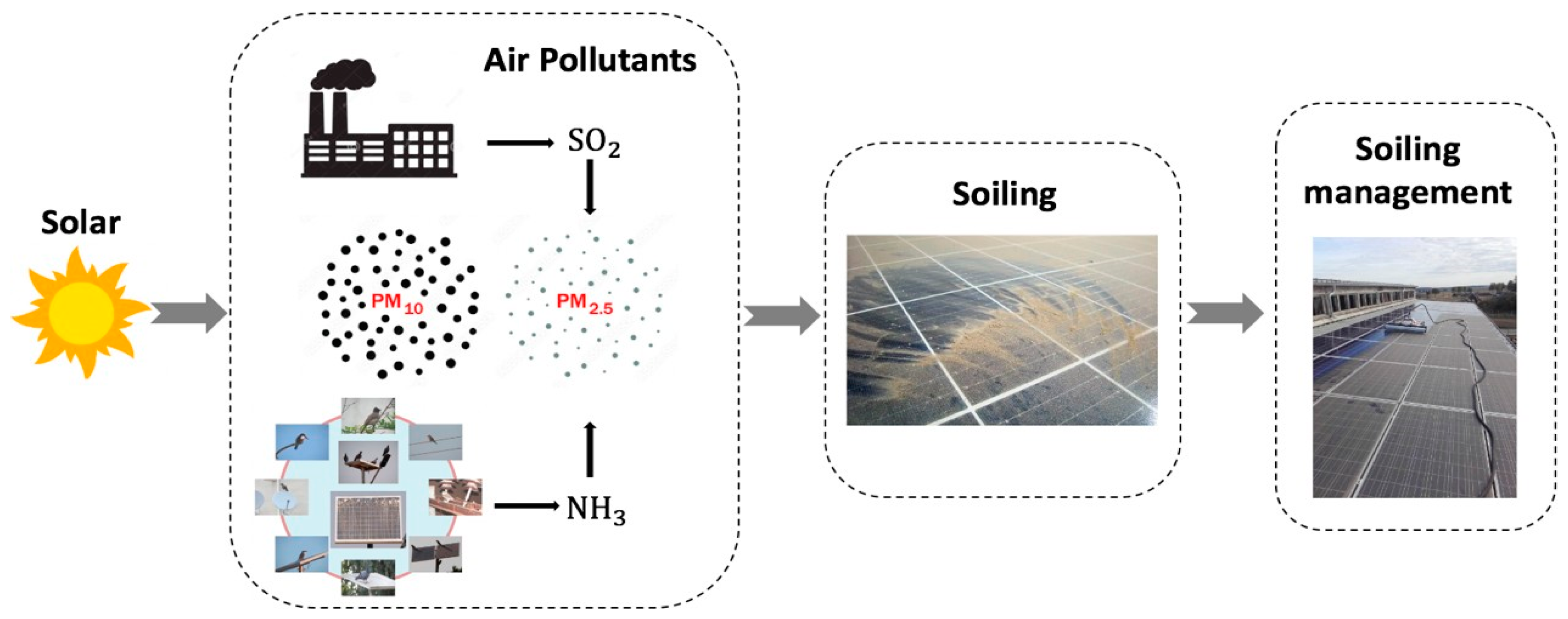
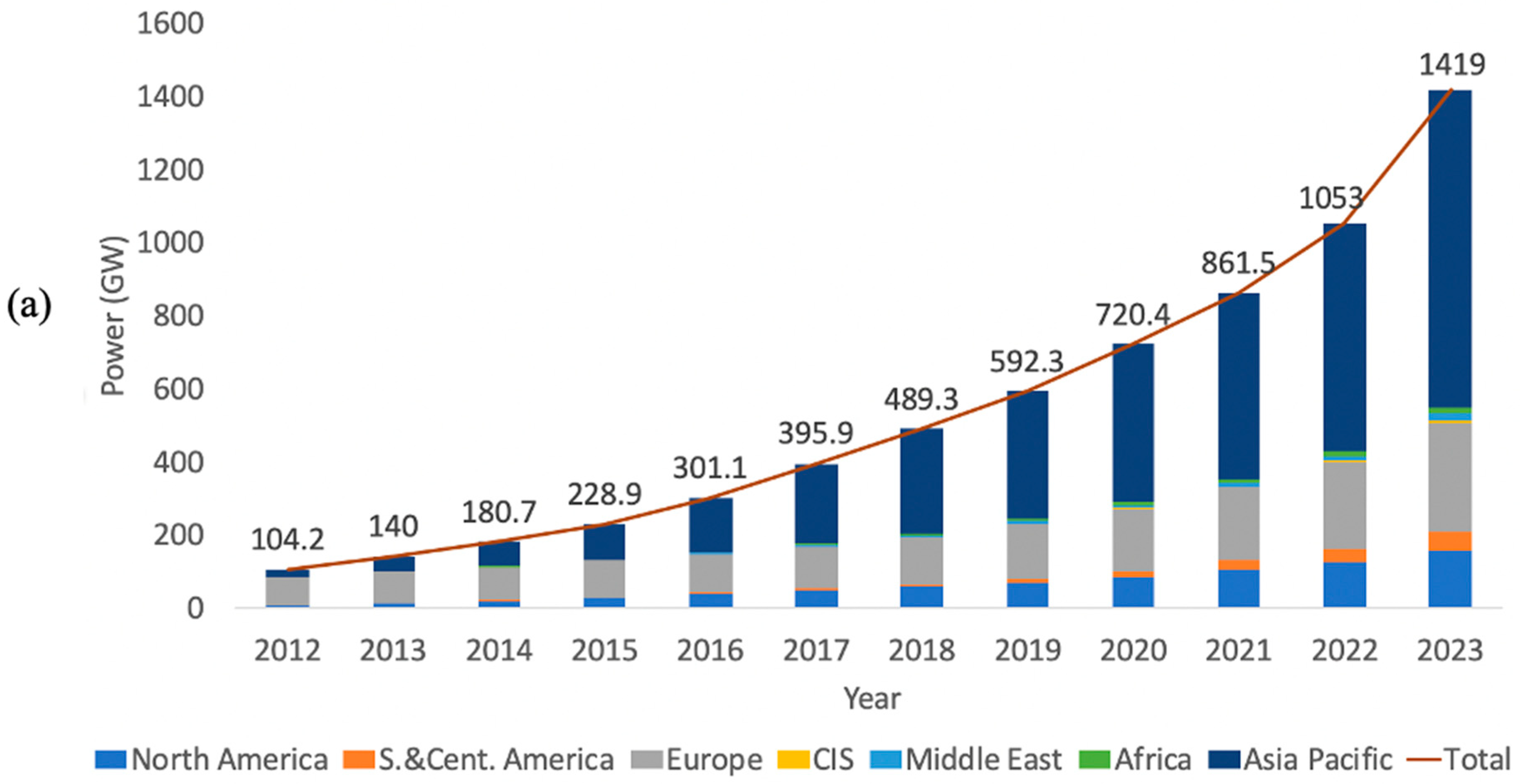
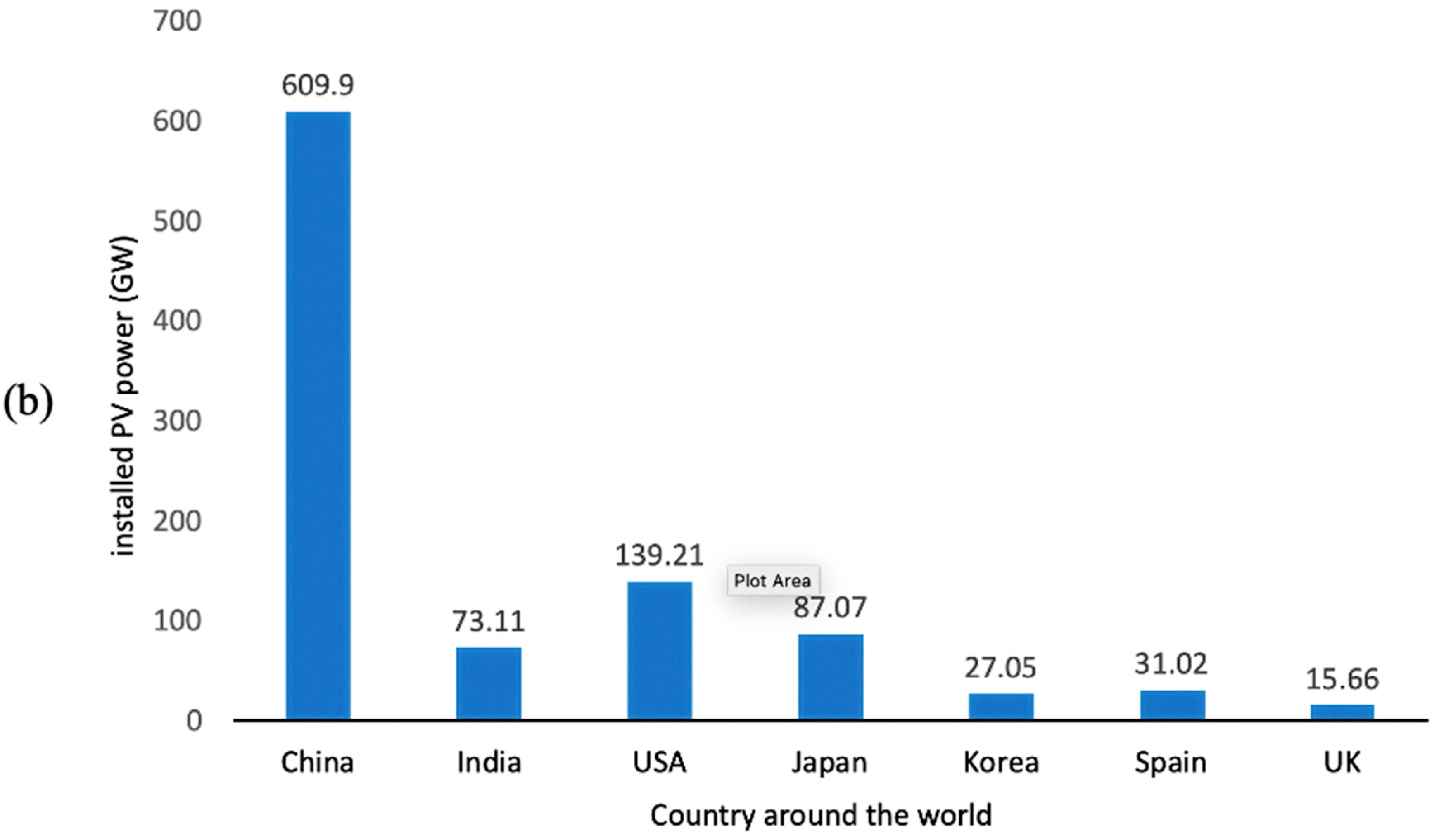
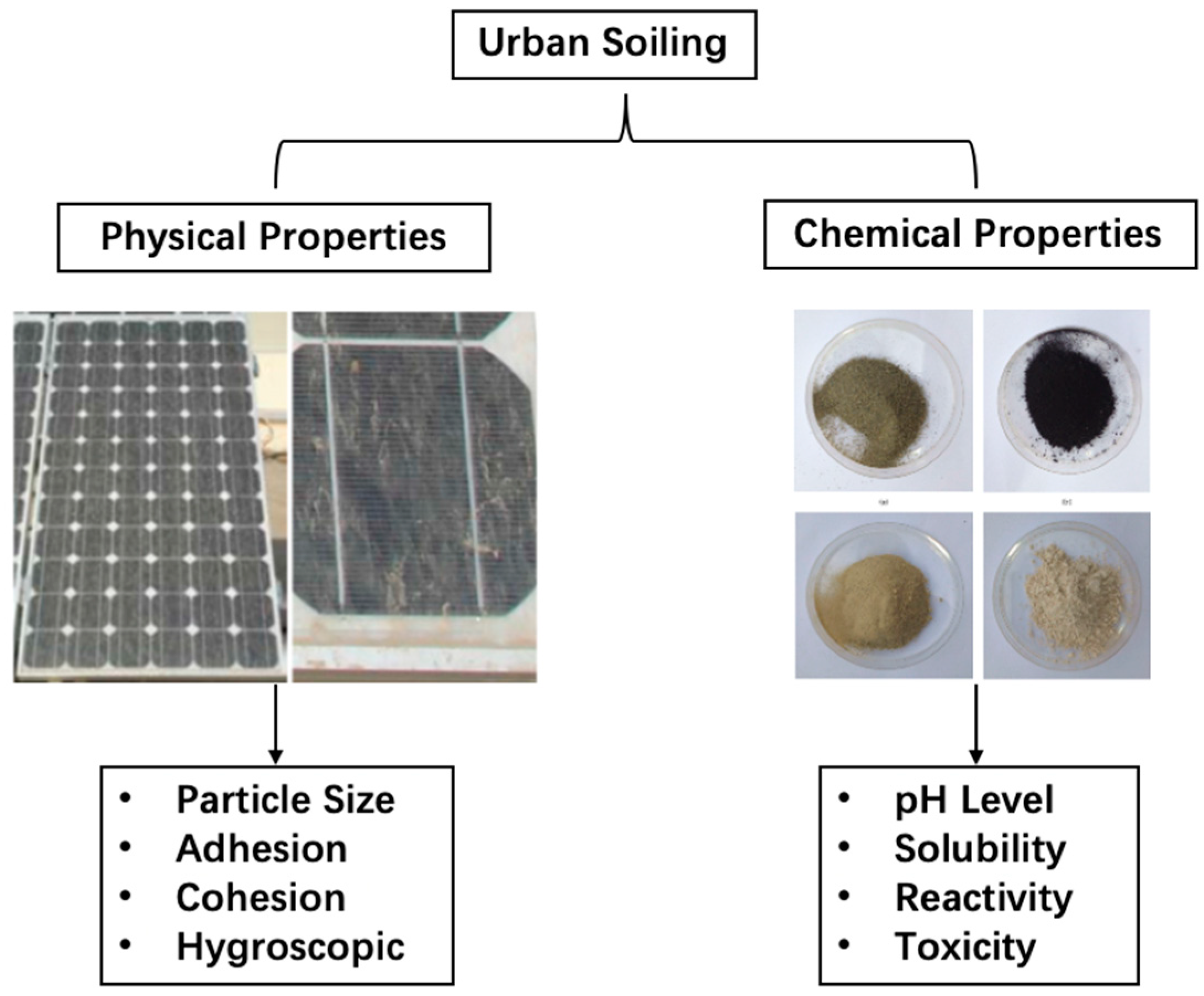
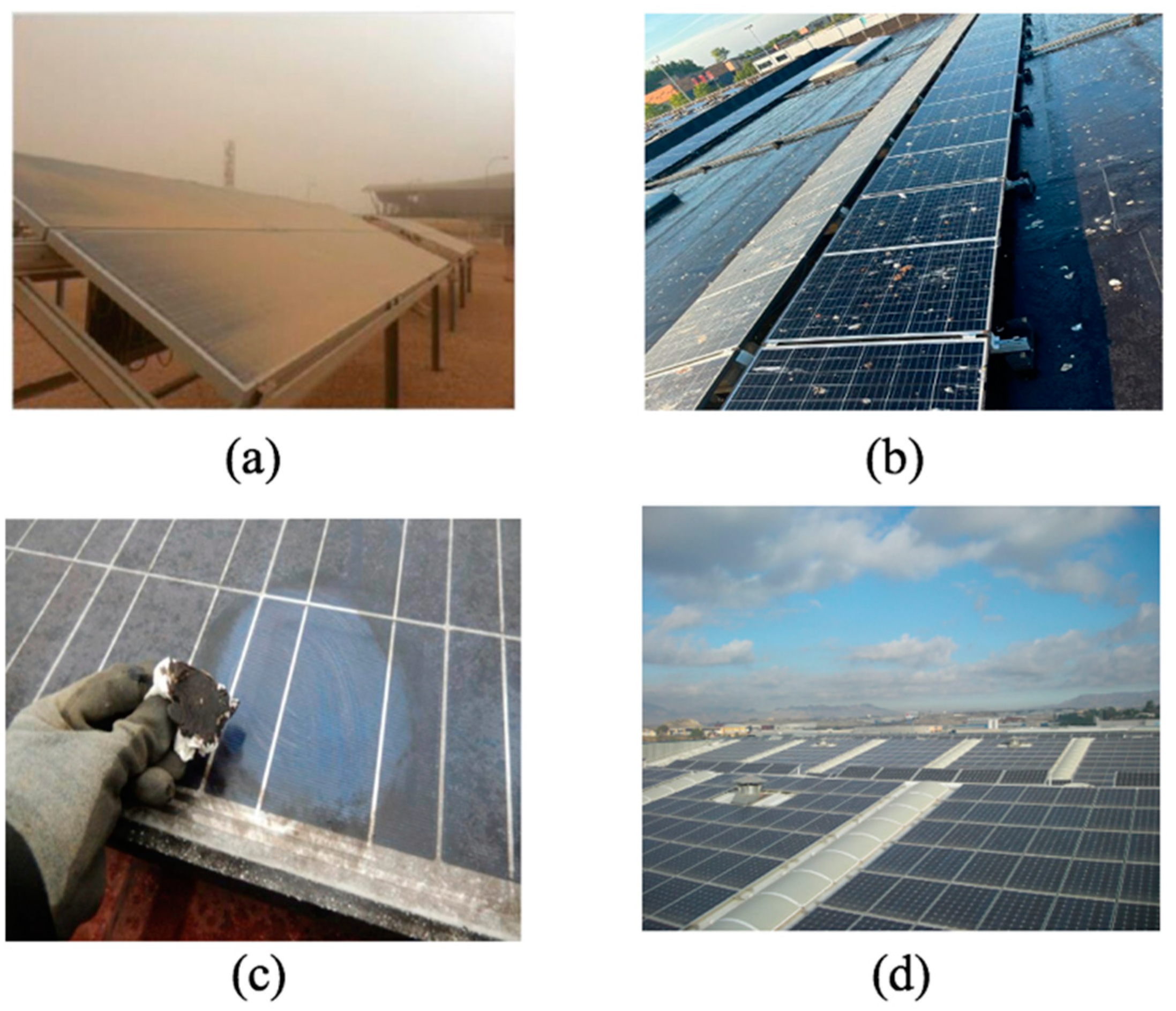
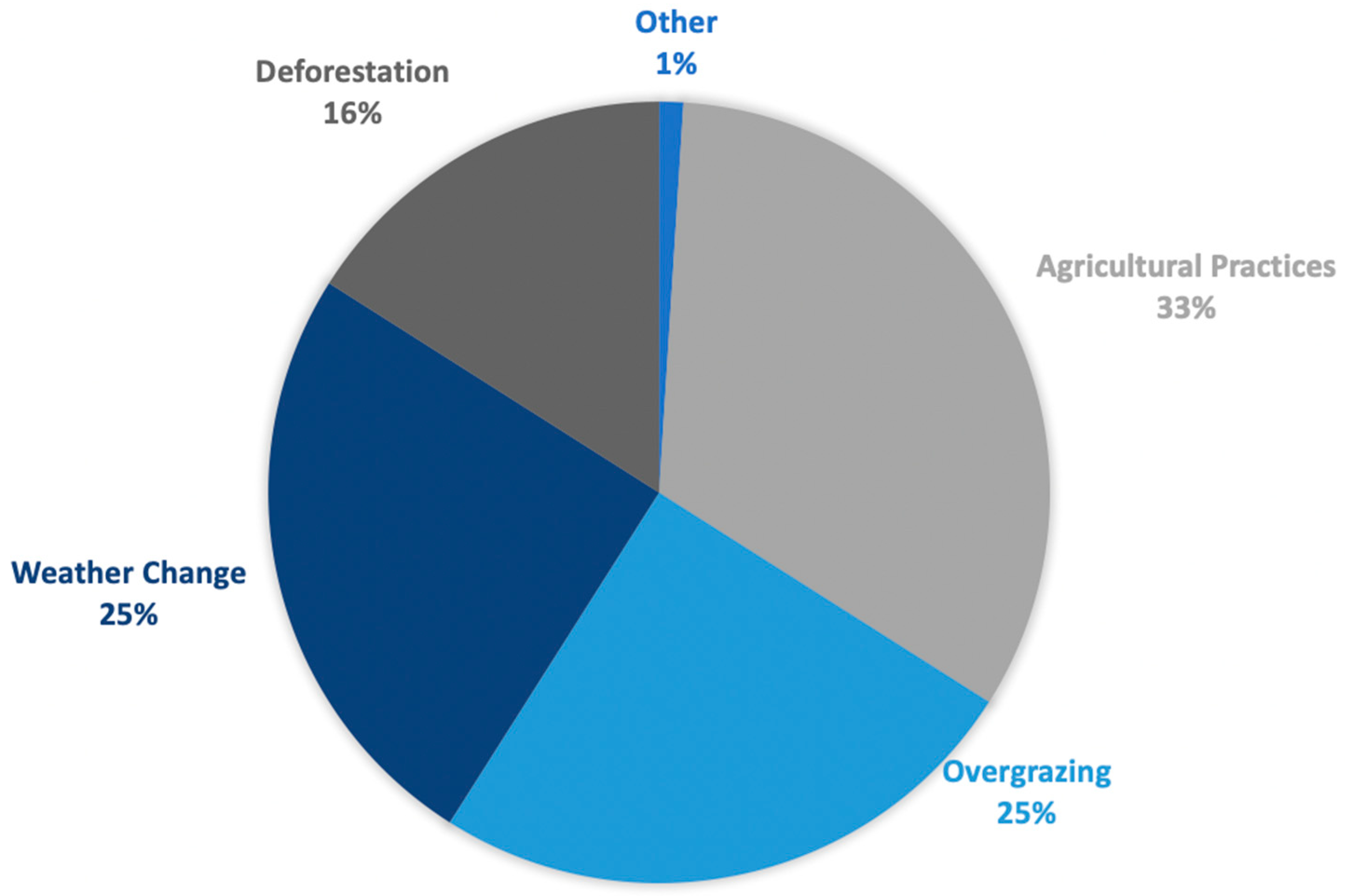
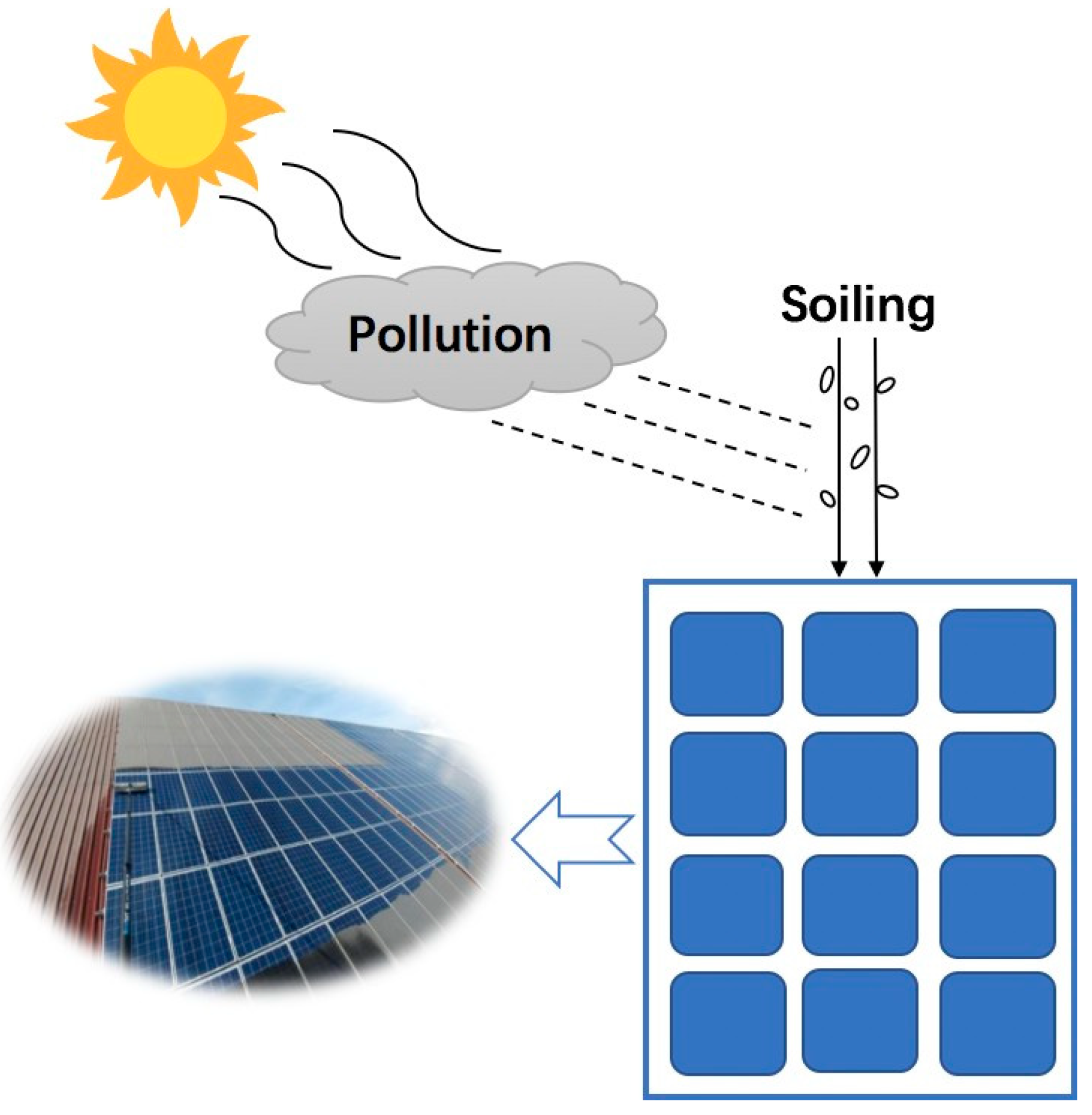


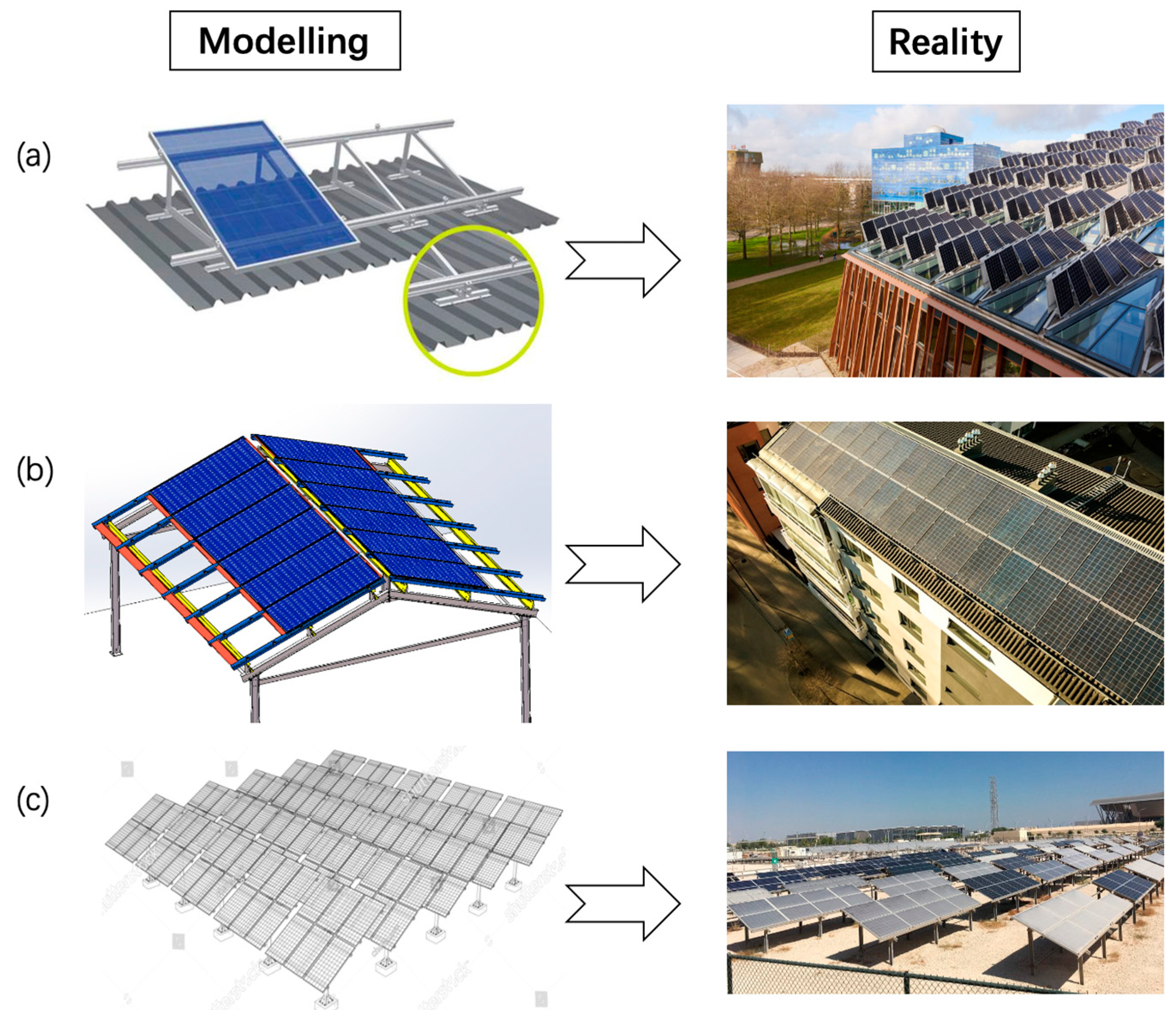
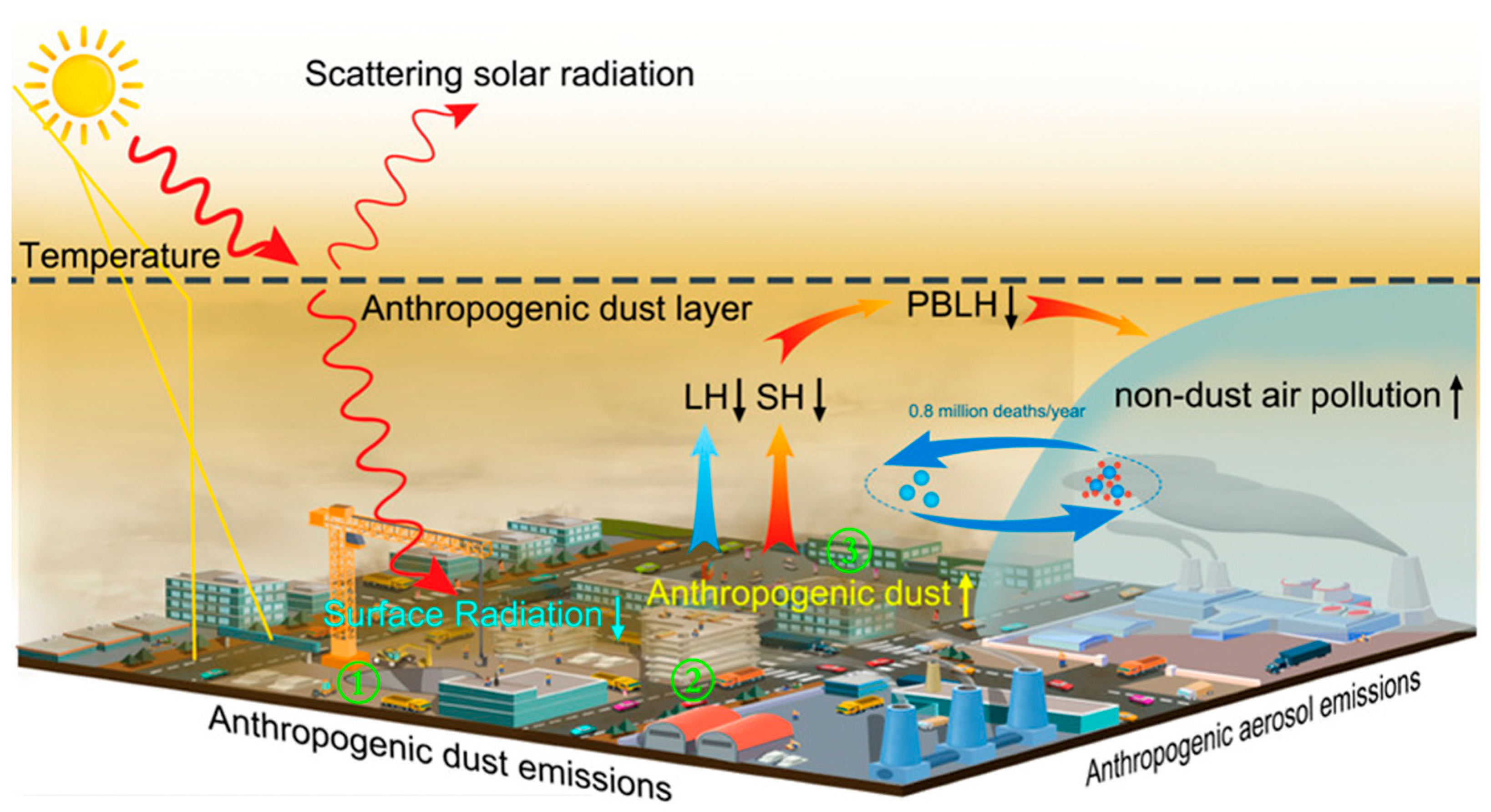
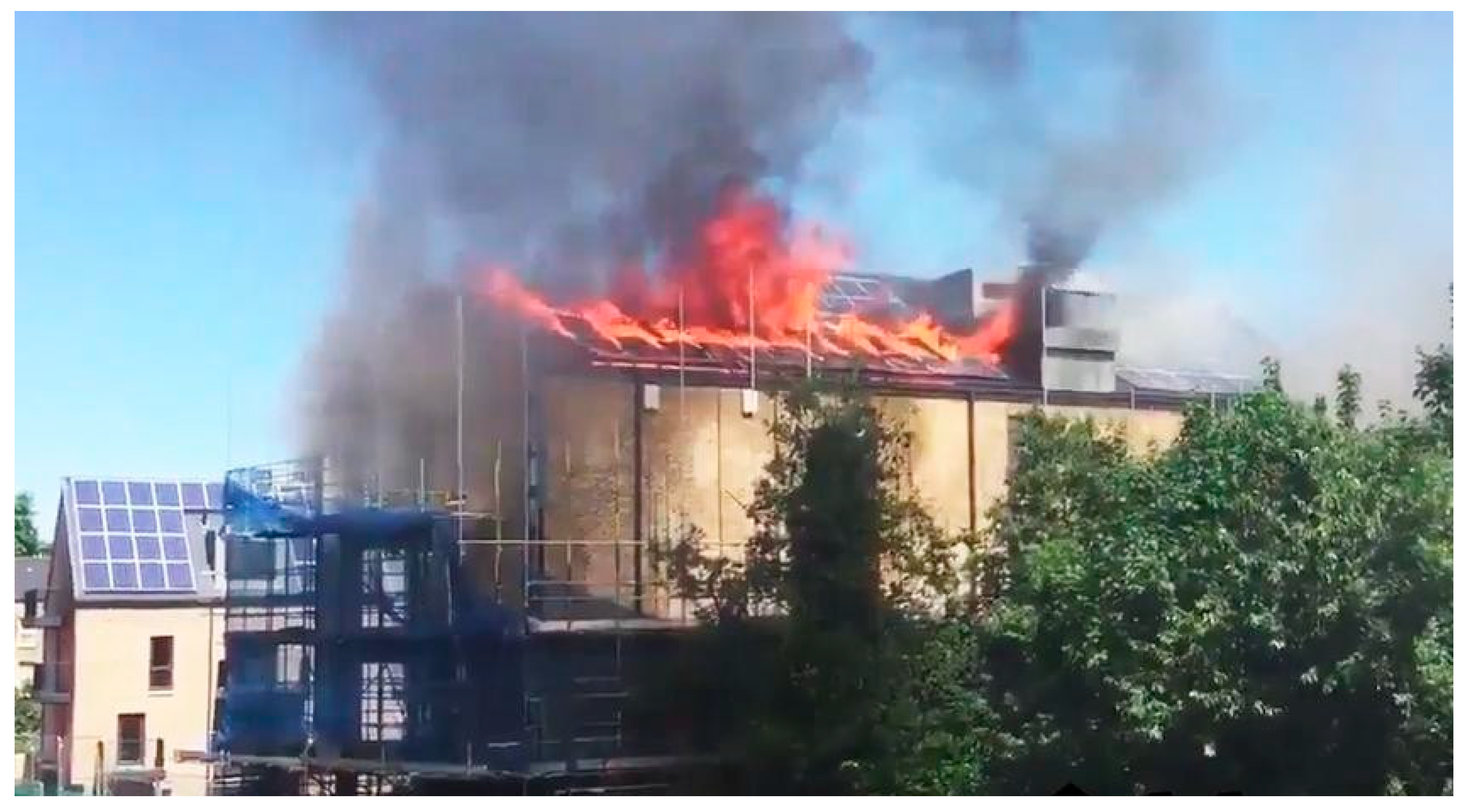
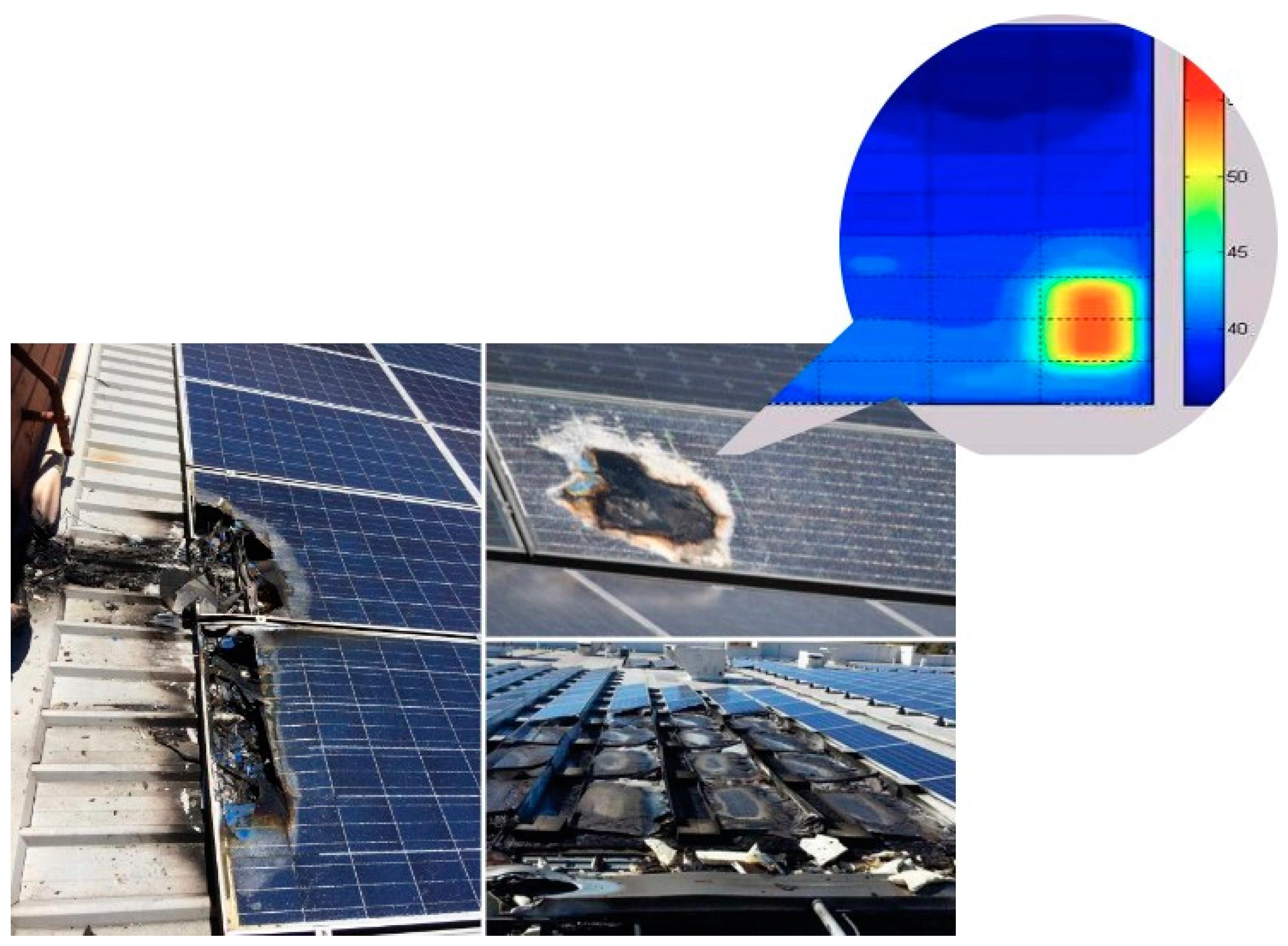
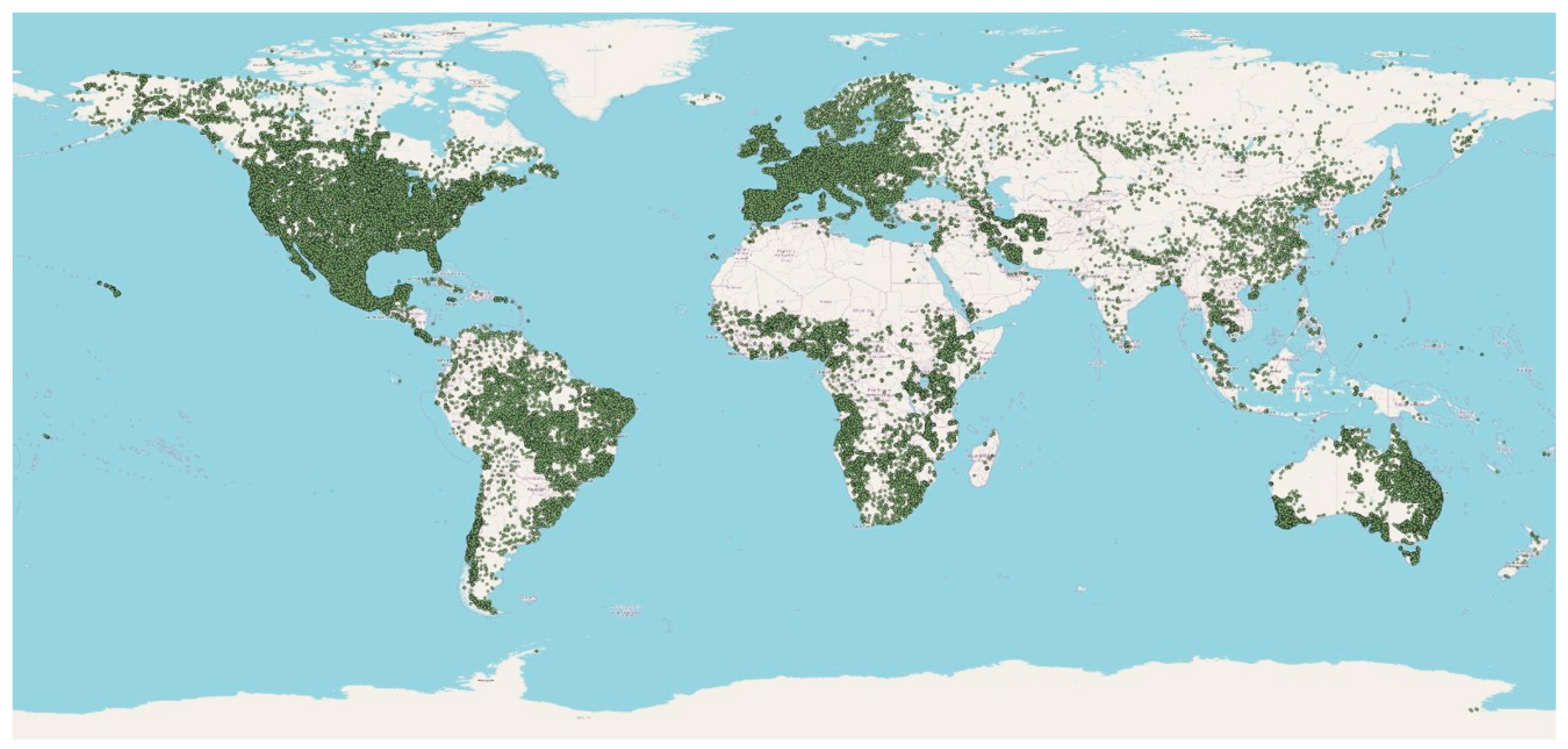

| Source Category | Specific Sources | Description |
|---|---|---|
| Transportation emissions | Brake and tire wear, non-exhaust emissions | Emissions from vehicles, including unburned hydrocarbons, metal particles, and soot from engine wear and combustion. |
| Industrial activities | Factories, manufacturing locations | Emissions from industrial processes, including particulates and gases. |
| Construction sites | Building materials, dust | Dust and debris from construction and demolition activities. |
| Energy production | Power plants | Emissions from energy generation, particularly the combustion of fossil fuels, sulfur dioxide emission, and nitrogen oxides into the atmosphere. |
| Urban infrastructure | Road, bridge, and building wear | Particulates generated from the wear and tear of urban infrastructure. |
| Biological materials | Bird droppings | Organic soiling from birds, and possible microbial growth. |
| Tilt Angle (deg.) | ) | Transmittance Reduction |
|---|---|---|
| 0 | 6.5 | 0.21 |
| 15 | 5 | 0.19 |
| 30 | 4.9 | 0.16 |
| 45 | 4.5 | 0.15 |
| 60 | 3.1 | 0.13 |
| 75 | 2.1 | 0.11 |
| 90 | 0.9 | 0.04 |
| 0 | 6.5 | 0.21 |
| 15 | 5 | 0.19 |
| 30 | 4.9 | 0.16 |
| 45 | 4.5 | 0.15 |
| 60 | 3.1 | 0.13 |
| 75 | 2.1 | 0.11 |
| Study/Project | Focus Area | Key Findings |
|---|---|---|
| PVCastSOIL [29] | Soiling losses on solar panels | Utilized a soiling test bench and glass coupons for long-term soiling characterization. Found variations in soiling impact based on tilt angle and environmental conditions. |
| Study on dust impact [2] | Impact of different types of urban soiling | Explored the differential effects of various pollutants (red soil, limestone, and ash) on the efficiency of PV systems. |
| Study on urban soiling impact [31] | Urban soiling and PV systems | Highlighted the need for research on urban agriculture and cultural services in the context of urban soil ecosystem services. |
| Global impact of aerosols [32] | Aerosols and PV generation | Investigated the worldwide effects of atmospheric aerosols and soiling at local and subnational scales. Considered the reduction in intensity caused by air PM and the deposition of PM on panels. |
| Method for measuring soiling losses [33] | Soiling losses in PV power plants | Methodology involved measuring I-V curves at both the module and string levels. Found higher soiling losses in I-axis trackers in rural surroundings and the varying effectiveness of cleaning methods. |
| Study on air pollution and soiling [35] | Air pollution, soiling, and PV systems | Analyzed the effect of air pollution and soiling on solar PV systems worldwide. Examined the reduction in PV capacity factors due to atmospheric aerosols in different regions. |
| Risk Factor | Description | Mitigation Strategies |
|---|---|---|
| Flammable material accumulation | Accumulation of flammable debris like leaves or organic material on solar panels. | Regular cleaning of panels to remove flammable materials; installation of barriers to prevent debris accumulation. |
| Electrical arcing and hot spots | Uneven soiling leading to hot spots and potential electrical arcing. | Regular examination and cleaning to ensure uniform dirt accumulation; monitoring system health to promptly identify hot spots. |
| Reduced productivity and excessive heat generation | Soiling results in reduced efficiency, leading to the panels overheating. | Implementing regular cleaning schedules; installing cooling systems or heat-resistant components into solar panels. |
| Deficient inspection and maintenance | Soiling obstructs the ability for inspection, resulting in maintenance being neglected. | Implementing regular inspection and maintenance schedules; using technologies for remote monitoring and diagnostics. |
| Chemical reactions | Chemical components in soiling can react with the materials of the panel, potentially leading to deterioration. | Use of protective coatings on panels to prevent chemical reactions; regular testing to ensure material durability. |
| Environmental conditions | Varied urban environmental factors like pollution can enhance soiling risks. | Selection of solar panels designed for urban conditions; integrating environmental monitoring for a proactive response. |
| Research Gap | Description |
|---|---|
| Composition and characteristics of urban soiling | Research is required to comprehend the specific composition of urban soiling, especially in various urban environments, and the effect on solar panel performance. |
| Impact of diverse urban pollutants | Studies focusing on how specific urban pollutants like vehicle emissions and industrial byproducts impact the efficiency of solar panels are limited. |
| Long-term degradation studies | There is a lack of longitudinal studies on how consistent exposure to urban soiling affects the structural integrity and performance of solar panels over time. |
| Effective cleaning and maintenance Strategies | Research into cost-effective, efficient, and sustainable methods for cleaning and maintaining solar panels in urban settings is lacking. |
| Soiling prediction models | Development of accurate and localized prediction models for soiling accumulation that consider the urban-specific factor is lacking research. |
Disclaimer/Publisher’s Note: The statements, opinions and data contained in all publications are solely those of the individual author(s) and contributor(s) and not of MDPI and/or the editor(s). MDPI and/or the editor(s) disclaim responsibility for any injury to people or property resulting from any ideas, methods, instructions or products referred to in the content. |
© 2025 by the authors. Licensee MDPI, Basel, Switzerland. This article is an open access article distributed under the terms and conditions of the Creative Commons Attribution (CC BY) license (https://creativecommons.org/licenses/by/4.0/).
Share and Cite
Zheng, B.; Hu, Y.; Alkahtani, M. Strategies to Reduce Urban Pollution Effects on Solar Panels: A Review. Solar 2025, 5, 11. https://doi.org/10.3390/solar5010011
Zheng B, Hu Y, Alkahtani M. Strategies to Reduce Urban Pollution Effects on Solar Panels: A Review. Solar. 2025; 5(1):11. https://doi.org/10.3390/solar5010011
Chicago/Turabian StyleZheng, Bingying, Yihua Hu, and Mohammed Alkahtani. 2025. "Strategies to Reduce Urban Pollution Effects on Solar Panels: A Review" Solar 5, no. 1: 11. https://doi.org/10.3390/solar5010011
APA StyleZheng, B., Hu, Y., & Alkahtani, M. (2025). Strategies to Reduce Urban Pollution Effects on Solar Panels: A Review. Solar, 5(1), 11. https://doi.org/10.3390/solar5010011








